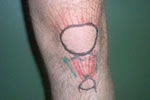| What Is It? |
Patellar tendonitis is an inflammation of the quadriceps muscle tendon. The most common site of occurrences is just below the knee cap where the tendon inserts onto the tibia (shin bone). |
| |
| How It Happens |
| Patellar tendonitis is a repetitive overuse syndrome. Excessive use of the quadriceps muscle will eventually lead to micro tears in the tendon producing local inflammation and possibly degeneration of the tendon. Muscle imbalance and poor lower extremity alignment are common contributing factors. In severe cases the patellar tendon may rupture. |

Black=Bone
Red=Muscle
Green=Pain |
| |
|
| Symptoms |
- Pain with palpation of the bottom of the knee cap
- Pain is dull, achy and localized to the area
- Pain is aggravated by resisting knee straightening, maximally bending knee, and contracting the quadriceps muscle in activities such as jumping
- No palpable defects in the patellar tendon
- Swelling and inflammation within the tendon
|
| |
|
| Testing |
X-rays are usually negative. May cause bony changes at the origin or insertion of the patellar tendon in severe and chronic cases. |
| |
| What Causes It? |
| Patellar tendonitis will most often evolve from repetitive knee extension activities such as jumping, running or kicking. It is also common to observe patellar tendonitis with sports such as basketball, volleyball and squash where there are many sudden stops and starts. Direct trauma to the patellar tendon can also be a predisposing factor to this type of injury. Again, muscle imbalance and poor lower extremity alignment are common contributing factors. |
| |
|
| What Should You Do? |
There are four stages of severity of a patellar tendonitis. Stage I is the least severe where there is pain only after activity and there is no functional impairment. A stage II injury presents a pain at the beginning and the end of activity, but is there is no pain during the activity. To begin, a warm-up prior to activity is important. The warm-up should be approximately 10 minutes in length and it must include a quadriceps stretching routine. Following activity, ice should be applied to the area of tenderness for 10 – 15 minutes and this can be repeated every hour as needed. If the symptoms continue to progress it will be necessary to modify the type of activities performed.
Activities such as swimming and biking will be less irritating to the patellar tendon than those activities involving deep knee bending.
In stage III and IV the severity of the injury has increased. There will be constant pain at rest and during activity or in the most severe case the tendon may rupture completely. With either situation it will be important to abstain from the aggravating activities. |
| |
| Will Physiotherapy Help Me? |
Physiotherapists are skilled in a variety of techniques that will help to improve healing in the tendon, in conjunction with modalities. Both of these treatments will help to improve the healing rate by decreasing the inflammation and the swelling in the tendon. Physiotherapists will also provide specific exercises for the injury and they will help to progress these exercises appropriately to prevent re-injury.
To learn more about how you can access and benefit from our services, please contact us today!
|

